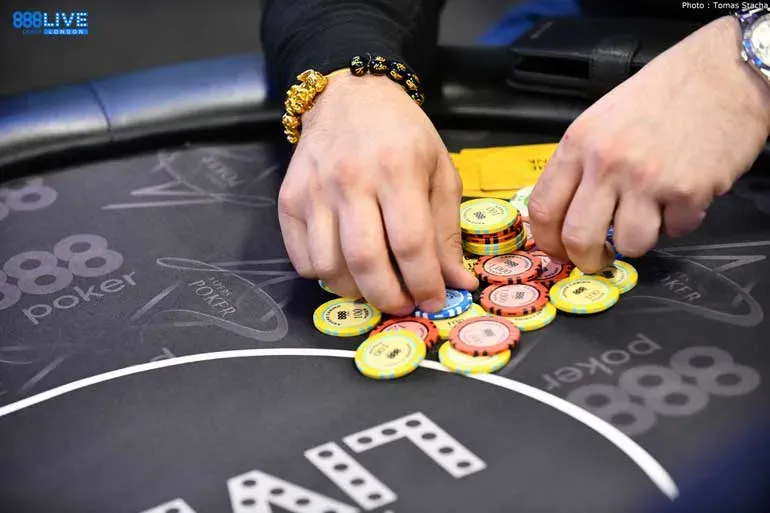Being first to act in each post-flop betting round in poker makes it very difficult to maximise your win rate and make optimal decisions.
- You have the least amount of information available to you (compared to in-position opponents).
- You won’t get to see first how your opponents act first.
So, to help you cultivate a solid out-of-position betting strategy, it’s imperative to incorporate check-raising into your poker betting arsenal.
In this article, we’ll expand fully on the check-raise, focusing on the following points:
Why Check-Raising Is Necessary in Poker
In the old days of poker, it used to be a pretty devious tactic to first check (signifying weakness) and then raise after your opponent bet.
Nowadays, it’s a commonplace well-developed poker strategy. It will also help you to balance out your gameplay.
Here are a few reasons why check-raising is essential:
- Aggressive Betting Lines: We all know that being aggressive in poker is the way to go. When you bet or raise, you have the two following ways to win:
- Win the pot by having the best hand at showdown.
- Gain fold equity (whereby your opponent folds and relinquishes their equity in the pot to you).
- Taking the Initiative: You have ultimate power in poker if you have the following –
- position in the hand
- the betting lead
- a range and/or nut advantage in the hand
Say you’re out of position post-flop and only called preflop. On most board textures, you’ll be at a significant disadvantage (with none of the above factors in your favour).
Check-raising allows you to take away the initiative from your opponent. They won’t have this full trifecta working in their favour anymore.

Check Raising: Taking the Initiative
- Denies Your Opponent Free Equity: Imagine your opponent bets the flop. If you never check-raise, they can cbet a lot more hands than usual on the flop. They can then check the turn and better realise their equity.
- Makes You More Difficult to Combat: Say, after you check, you always call or fold. Your opponent can freely bet a broader range of hands for value and also as bluffs. Now you incorporate a check-raise strategy. You’re going to make your opponent think twice about value betting thinly (or bluffing so liberally) in position.
- To Increase Size of the Pot: It’s essential to get creative and formulate different ways to increase the size of the pot - especially in deep-stacked games. This way, you can play for stacks more easily and set yourself to go all-in on the river.
- Example #1 – Donk-Betting Twice: Imagine there’s 5.5bb in the pot. You decide to take the betting lead (out of position) and bet 50% pot - your opponent calls. With 11bb in the pot on the turn, you now bet 50% pot once more, and again, your opponent calls. By the river, there’s now 22bb in the pot.
- Example #2 – Check-Raising Twice: Imagine there’s 5.5 bb in the pot. You check, and your opponent bets 2.7bb (50% pot). You raise to 10bb - your opponent calls. With 25.5bb in the pot, you now check the turn, and your opponent bets 50% pot again for 12.25bb. You check-raise to 40bb - your opponent calls. Now we enter a river scenario where there’s 105.5bb in the pot, instead of the mere 22bb - as in the example above.
- Example #1 – Donk-Betting Twice: Imagine there’s 5.5bb in the pot. You decide to take the betting lead (out of position) and bet 50% pot - your opponent calls. With 11bb in the pot on the turn, you now bet 50% pot once more, and again, your opponent calls. By the river, there’s now 22bb in the pot.
- To Balance Out Your Checking Strategy: Traditionally, checks indicate weakness in a hand. By including hands in your range to check-raise for value, you strengthen your checking range and become much more difficult to combat.
- Usually Helps “Thin the Field” in Multi-way Pots: It’s no secret that you have a better chance of winning when you’re facing one opponent (versus multiple opponents). As such, check-raising as a post-flop “squeeze play” can be advantageous. It both helps build a pot and thins the field in an attempt to get heads-up.
What Factors Must Be Present to Check-Raise
There are a few things required to be able to check-raise effectively in poker:
- You Must Be Out of Position: You can’t check-raise somebody if you’re in position. If you check, the next community card would then be dealt. The betting for that round would be over.

Check Raise Aggressive Opponents
- It’s Ideal If Your Opponent is Aggressive: Check-raising only works if your opponent bets! As such, it’s a great tactic to use on aggressive opponents (who will likely bet if you check).
Note that you should not always check-raise your strong hands against aggressive opponents. Sometimes it’s best to give your opponents a chance to keep betting or bluffing on later streets, too.
- You Must Balance Your Check-Raising Range: If you only check-raise your value hands, you become relatively easy to play. Players will be able to fold their medium to strong hands against you. They know that they won’t be likely to beat anything if they call.
Also, it severely weakens the range of hands included in your checking range. That said, be sure when adding bluffs into your check-raising range that you are highly selective. Check-raise bluffing too frequently will do massive damage to your table image and winrate.
General Strategies for Building Check-Raising Ranges
When To Check-Raise in Poker
When the flop favours the preflop raiser (assuming you’re the player in the big blind), generally, you want to avoid check-raising altogether.
Examples of flops such as these could include broadway boards like A-K-Q, K-K-J, etc.
You want to avoid check-raising from the big blind because your opponent has both a range and nut advantage in these instances. In other words, your opponent can have all the big pairs (full houses), overpairs, and strongest two pair/trip broadway combinations.
You would’ve3bet, instead of flatting from the big blind, with many of those combinations in your preflop range.
On boards that favour you (i.e., low boards from the big blind against an UTG Villain: 6-4-3. 4-4-2. 8-5-2, etc.), you can check-raise more liberally.
Your range interacts stronger with boards of these textures than their range does.
Check Raising for Value
You’re going to want to build a pot and gain value by check-raising your strong hands in poker.

Check Raising for Value
Note that a “strong hand” is relative to the board texture and game format.
- Flopping two pair on a dry board is undoubtedly going to be quite strong
- Flopping two pair on a monotone board of 8-7-6 doesn’t make you want to “fist-pump/get-it-in” with a XR (check-raise)and barrel.
After you check-raise for value on the flop, you’re usually going to want to continue firing to the river. Only in rare select circumstances will it be correct to go for a double check-raise or the even crazier, the legendary triple check-raise!
In other words, as a general rule of thumb, don’t get tricky!
Once you’ve taken the betting lead, continue firing unless the board texture changes dramatically. In those scenarios, you might want to opt to slow down instead.
Another topic that needs addressing in this section is the importance of check-raising for protection. You should use this strategy with some medium-strength hands, on low boards, especially after your opponent bets small. (Examples of hands to include are the most vulnerable overpairs you might have.)
- This concept is primarily for when you’re in the big blind in a single-raised pot.
- But you can also apply it in non-blind positions when OOP in 3bet pots.
Imagine your opponent cbets in position on a board like 7-4-2. Your opponent will frequently have two overcards to the board and still a decent chunk of equity versus a one-pair holding.
So, if you have 88 or 99 in your BB defend range, you should often XR (check-raise) for protection. It’s pretty easy for a broadway card to hit on the turn or river.
- You don’t want your opponent to realise their equity for free if you call, and they check the turn.
- Additionally, by NOT check-raising, you put yourself in a tricky situation to call down any overcard turn/river runouts with those vulnerable pairs.
That said, you won’t necessarily want to XR and barrel down both turn and river. You would likely be overplaying your hand in many cases.
But check-raising them, nonetheless, is a formidable play on the flop for the following three reasons –
- It gains you value
- Denies your opponent from freely realising their equity
- Also, it will help simplify some of your decisions later in the hand
Check Raising as a Semi-Bluff / Bluff
Draws with no showdown value (SDV) will be the best candidates to check-raise. You can’t profitably call two streets (flop/turn) and win on the river without the betting lead and no real SDV!
So, check-raising lower flush draws, and some straight draws will be a sound strategy. You usually won’t want to check-raise ALL your straight draws because you may end up OVER-bluffing!
But if you do this at least a portion of the time, you’ll undoubtedly be more well-balanced.

Check Raising as a Semi-Bluff / Bluff
On specific boards, you’re going to have to get creative with your bluffs.
For example, on a board of K-8-3 rainbow, there are no direct straight draws or flush draws.
So, what might be some good bluff candidates?
Look for some hand combos that contain multiple backdoor draws. Say you have a hand like T9s or 97s with a backdoor flush draw. These are prime check-raising candidates. They can keep you barrelling on a variety of equity-filling turns.
Note that you’re going to want to check-raise with more bluffs than value hands on the flop.
Be sure that, as the hand progresses, you don’t continue barrelling 100% of your check-raising bluff hands. You’ll have too many bluffs by the turn and river.
Remember, you’re going to have some “give-ups” along the way.
In general, giving up with some of your strongest flush draws on the river is going to be the way to go. After check-raising the flop and barrelling down, you should go the distance with your missed straight draws, and perhaps some of your weakest flush draws with no SDV. You unblock your opponent from having some of those flush draws they would fold on the river.
Against polarised (larger) bet sizings, it’s going to be advisable to check-raise your strongest draws for bluffs as part of your check-raising strategy.
Tips for Adjusting Your Check-Raises in Poker
Keep in mind that it doesn’t make sense to try and bluff a calling station.
Depending on your opponents’ tendencies, you may need to adjust your baseline “GTO” check-raise strategy.
Here are a few check-raising tips, including some Villain-specific ones:
- If you know your opponent will call you light after check-raising, don’t check-raise bluff as much.
- Say you know your opponent will bet their draws AND call a check-raise of any size. Check-raise on the larger size for value to charge them appropriately.
- If your opponent overfolds to check-raises, add more bluffs into the mix and up that overall XR frequency.
- If your opponent has a very high flop cbet %, attack their cbet with a higher-than-normal check-raise frequency. Do this, especially on dry flops when they frequently miss and have to fold to check-raises.
- If your opponent’s bet was large, you should check-raise at a much lower frequency.
- If your opponent’s bet was small, you should generally check-raise wider for value and at a much higher frequency.
- Try to mix in value check-raises on each street to remain balanced. For example, on a board of T-5-2, say you can have all three sets. Your check-raise strategy could include the following –
- Check-raising most of your set of 2’s and 5’s combos on earlier streets
- Trapping the set of T’s
- Selecting a few others of the 2’s and 5’s to check-raise on later streets
- Say your opponent is aggressive and bluff-happy. Checking (with the ultimate intention of check-raising at some point) can often be more effective than betting. It keeps your opponents range wide for their bluffs.
Against these opponents who like to fire three streets with air, it can be advantageous to check all the way to the river. Allow them to fire for three streets before coming in for your check-raise.
- If you check-raise to a large size, theoretically, you should be able to include more bluffs in your range.
- If you check-raise to a smaller size, theoretically, you should have fewer bluffs and a wider, more merged range of value combos.
Check Raising: The Bottom Line
Check-raising is a necessary tool in your poker arsenal if you want to become a feared and profitable player.
You’ll always have a tough time manoeuvring your hands out of position, especially when defending in the blinds.
- Learning to check-raise effectively will help boost winrate in these positions.
- It will also help balance out all your available betting lines.
Be sure to incorporate some of the concepts from this article into your next poker session.
Until next time, check-raise well and good luck at the tables!


